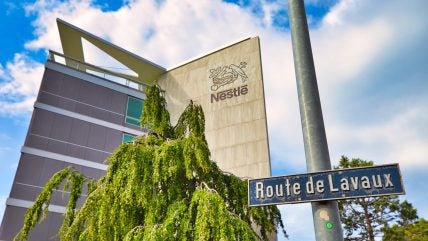
Nestlé’s underlying sales growth metric turned negative in its third quarter despite an acceleration in pricing.
The world’s largest food manufacturer trimmed the number of “underperforming” SKUs at the start of the second quarter as a hedge against the continuing rise in input costs and longer-than-anticipated supply-chain pressures.
As a result, third quarter real internal growth (RIG), which strips out pricing from organic growth, was minus 0.2%, compared to plus 0.9% in the prior three months and 4.4% from a year earlier, Nestlé said today (19 October).
However, CEO Mark Schneider sought to reassure analysts over the RIG transition on a follow-up discussion on the Nescafé maker’s nine-month results. The SKU cuts would have a positive effect on other areas of the portfolio, he suggested.
“This strategy, which we call cut the tail to push the head, is one of our ways to counter cost pressures and supply-chain limitations,” Schneider explained. “It is one of several strategies that enabled us to limit the pressure on our underlying trading operating profit margin compared to the reduction we witnessed in our gross margin.
“Over time, this strategy is also expected to give us top-line benefits through better on-shelf availability and visibility of our core SKUs.”

US Tariffs are shifting - will you react or anticipate?
Don’t let policy changes catch you off guard. Stay proactive with real-time data and expert analysis.
By GlobalDataThird-quarter organic growth was 9.3%, translating to a negative RIG, based on pricing of 9.5%. However, over the nine months, RIG was positive at 1%, with pricing of 7.5% and an organic print of 8.5%.
Schneider reiterated a conservative approach on pricing to ease the pain for consumers but still anticipates more to come over the course of the year and into 2023 as Nestlé continues to play “catch-up” with cost inflation.
“We maintained our responsible approach to pricing, but further pricing steps were clearly needed to react to significant levels of global inflation hitting us,” he said.
Heading off questions about the outlook for RIG, he added: “Short term, and in the face of extraordinary pressures, this is unavoidable and should not be a cause for concern. As we look at next year and beyond, we continue to work towards a healthy development of our volume and mix.
“Our volume growth, which remained positive in the first half, turned slightly negative. In addition to supply-chain constraints, and the super-high base of comparison, volume development was reduced by active and conscious choices to cut the number of low rotation and underperforming SKUs.”
Schneider said the SKU programme was kicked off as the start of the Ukraine conflict in February made it clear “inflation was going to be a much more significant factor” this year than in the preceding 12 months. The lingering effects of Covid on supply chains have persisted longer than expected.
The rationalisation programme is a global effort but is particularly centred on Nestlé’s Asia, Oceania and Africa (AOA) operating division. That generally sits within emerging markets, which posted nine-month organic growth of 10.2%, compared to 7.4% for developed countries.
Nestlé sales include slowing e-commerce growth
At the group level, year-to-date reported sales amounted to CHF69.1bn (US$68.8bn), an increase of 9.2%.
Retail was up 7.3% in organic growth terms but within that segment, e-commerce sales slowed to 8.4% from 17.2% a year earlier. Foodservice, or out-of-home, rose 26.1% with actual sales above pre-Covid in 2019, Nestlé said.
Pricing was more noticeable in North America and Latin America – 11.1% and 10.5%, respectively, versus 5.7% in Europe. In AOA it was 7% and in China, where Covid is having a lasting effect with further rounds of lockdowns, 2.6%.
CFO François-Xavier Roger explained the impact on consumers. “We have seen limited demand elasticity so far. We are seeing some, more specifically in food and dairy, but the level remains limited in the context of the pricing actions we have had to take.”
However, western Europe is a cause for concern with rising energy prices adding to the pain of higher living costs. At the annual Barclays Consumer Staples Conference last month, Roger outlined a plan to combat the crisis. “We have set up a contingency plan and business continuity plans. There are two main things that we can do: the first one is to convert whenever possible the source of energy from gas to oil; whenever it’s not possible, we will pile up inventory ahead of the winter to make sure that we can supply our customers.”
Today, he said Nestlé could expect some trading down in Europe. “We are concerned by the outlook in western Europe, especially so that the energy crisis that is coming is essentially a European one that will hit consumer purchasing power. So we are a little bit more concerned for Q4, Q1 and Q2 next year but so far so good, but something we are monitoring very closely.”



